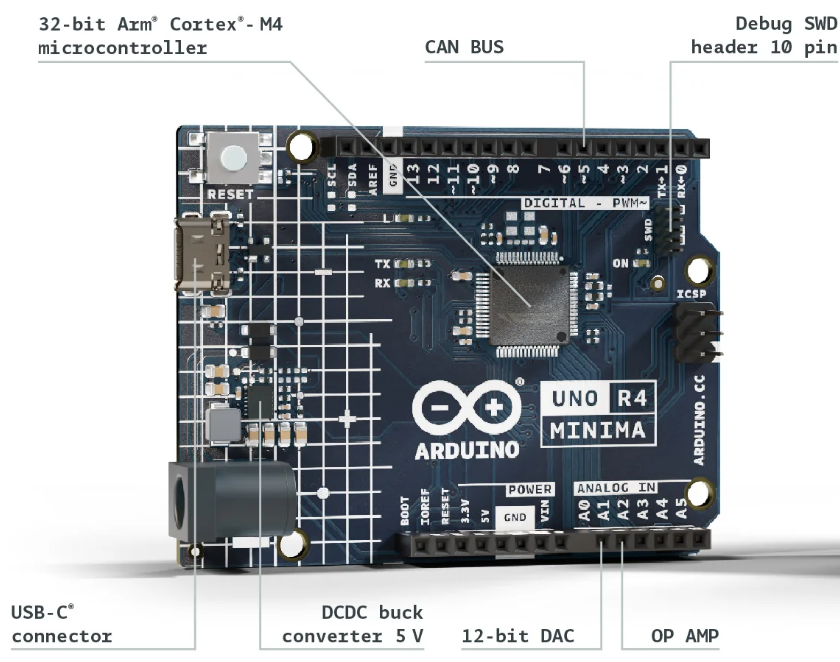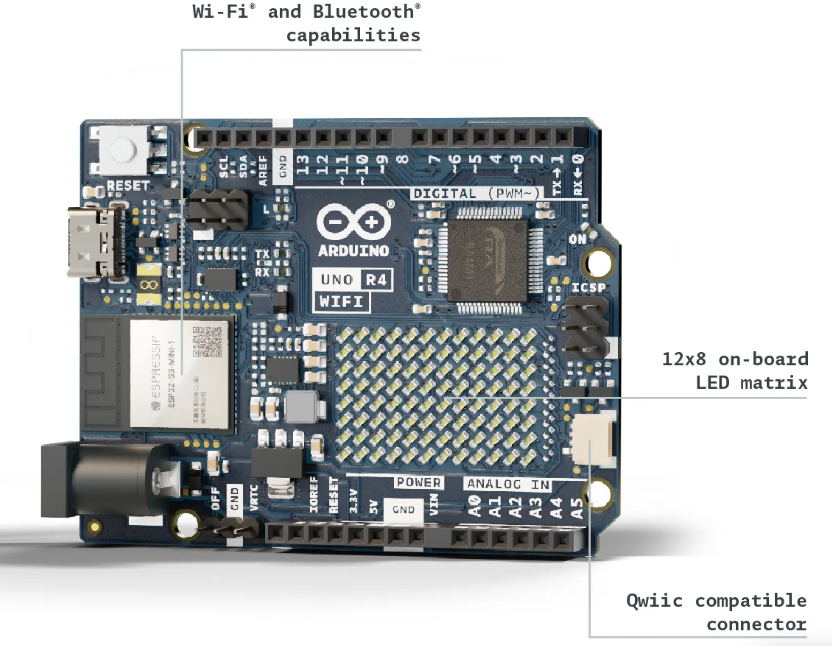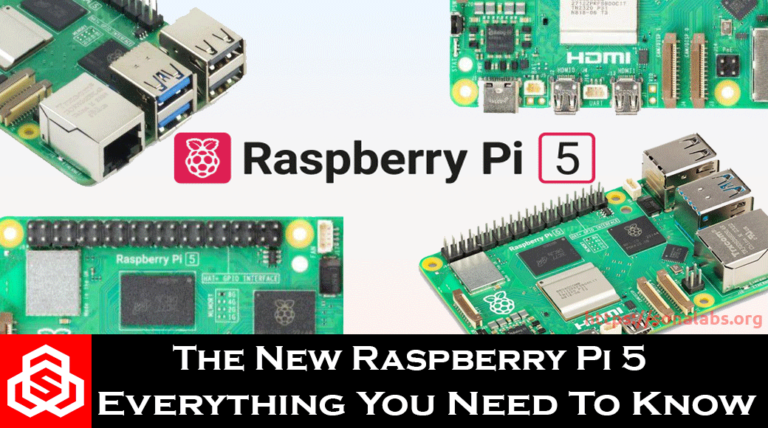The new Arduino Uno Rev-4 (Everything you need to know)…
The all new and improved fourth version of the Iconic Arduino UNO board, the Arduino UNO R4 is here… The UNO R4 was first announced on Arduino Day in March-2023 and it was released to the public towards the end of last month (June-2023). The Arduino UNO R4 comes in two variations; the Arduino UNO R4 Minima and the Arduino UNO R4 WiFi.
Let’s take a closer look at each of these new boards;
The Arduino UNO R4 Minima:
The Arduino UNO R4 Minima is the upgraded lightweight version of its predecessor, the UNO R3.
The new UNO R4 Minima has the following features:
- The board is equipped with a powerful 32-bit Arm Cortex-M4 microcontroller- (the RA4M1 Microcontroller from Renesas) which provides 16 times more memory and additional peripherals.
- Both the new UNO R4 Minima & UNO R4 WiFi boards share the same UNO form factor (with the same dimensions), same pinout, and same 5v operating voltage as their predecessor, the UNO R3 board.
- The UNO R4 Minima boasts increased memory and a faster clock speed empowering the user to handle demanding tasks effortlessly.
- The UNO R4 Minima introduces a range of on-board peripherals, including a 12-bit DAC, CAN BUS, and OP AMP. These additional components provide you with expanded capabilities and flexibility in your designs.
- The UNO R4 Minima has a larger input voltage range and it allows power supply up to 24V. By using a single power supply, this enables smooth connection with motors, LED strips, and other actuators, simplifying your projects.
- When connected to a computer using a USB cable, the UNO R4 Minima can simulate a mouse or keyboard thanks to built-in HID (Human Interface Device) functionality. Keystrokes and mouse movements can be easily transmitted to a computer using this capability, which improves usability and functionality.
- The SWD Connector that is included with the UNO R4 Minima is utilized for debugging, an essential part of any project. To do this, all you need to do is to connect an external debugger to the UNO R4 Minima and monitor your system’s internal operations with ease.
The Arduino UNO R4 WiFi:
The Arduino UNO R4 WiFi is simply another variation of the new UNO R4 that allows you to explore the world of IoT (Internet of Things) or to simply upgrade your existing project and add wireless connectivity to it.
The UNO R4 WiFi combines the processing power and exciting new peripherals of the RA4M1 microcontroller from Renesas with the wireless connectivity power (Wifi & Bluetooth) of the ESP32-S3 from Espressif.
The new UNO R4 WiFi has the same new features just like the UNO R4 Minima as stated above except for it, it has more features to offer and these additional features include:
- The UNO R4 WiFi hosts an ESP32-S3 module, enabling makers and D.I.Y creators to add wireless connectivity (WiFi & Bluetooth capabilities) to their projects. Combined with the Arduino IoT Cloud, makers can monitor and control their projects remotely.
- The UNO R4 WiFi features a Qwiic I2C connector, allowing easy connection to nodes from the extensive Qwiic ecosystem. Adapter cables also enable compatibility with sensors and actuators based on other connectors.
- The UNO R4 WiFi includes additional pins, including an “OFF” pin to turn off the board and a “VRTC” pin to keep the internal Real-Time Clock powered and running.
- The UNO R4 WiFi incorporates a bright 12×8 red LED matrix, ideal for creative projects with animations or plotting sensor data, eliminating the need for additional hardware.
- The UNO R4 WiFi includes an error-catching mechanism that detects runtime crashes and provides detailed explanations and hints about the code line causing the crash.
Comparison of the old UNO R3 with the new UNO R4:
| Specifications | Arduino UNO R3 | Arduino UNO R4 (Minima & WiFi) |
|---|---|---|
| Microcontroller | ATmega328P 8-bit Processor | Renesas RA4M1 (Arm Cortex-M4) 32-bit Processor |
| Programming Port | USB-B | USB-C |
| Pins | 14 digital pins – 6 of which provide PWM output 6 Analog Input Pins 0 Analog Output Pins 2 External Interrupts | 14 Digital I/O pins 6 PWM Pins 6 Analog Input pins, 1 DAC. 14 External Interrupts |
| Communication | UART, I2C SPI | UART-4x, I2C-1x, CAN-1 CAN Bus SPI-1x (Only on UNO R4 WiFi) |
| Power | 5v-(Operating Voltage), 7-12v-(Input Voltage- Recommended), 6-20v-(Input Voltage-Limit) | 5v-(Circuit Operating Voltage), (ESP32-S3 is 3.3v) 6-24v-(Input Voltage – VIN), 8mA-(DC Current per I/O Pin) |
| Clock Speed | 16 MHz | 48 MHz (Main Core) |
| Memory | Flash Memory – 32kB – (ATmega328P) of which 0.5kB is used by Bootloader, SRAM – 2kB – (ATmega328P), EEPROM – 1kB – (ATmega328P). | RA4M1-256kB Flash Memory, 32kB RAM 0kB EEPROM |
| Dimensions | Length-68.6mm, Width-53.34mm | Length-68.85mm, Width-53.34mm |
Downloads:
Conclusion:
For any tech enthusiast/hobbyist/engineering-student, if you’re looking for a light-weight version of the new Arduino UNO R4, then you can try out the Arduino UNO R4 Minima but if you’re looking to upgrade your current project with Wireless connectivity (to add WiFi and or Bluetooth capabilities), or you just want to explore the world of Internet of Things (IoT) with the new Arduino UNO, then the Arduino UNO R4 WiFi is the right board for you.
If you liked this blog post about the new Arduino UNO R4, please subscribe to our YouTube Channel for more D.I.Y tutorials, updates and projects.
Leave a comment down below incase you have any questions about this new Arduino UNO Board.
Follow us on our different social media platforms;- LinkedIn, Facebook, Instagram, TikTok, & Pinterest.










